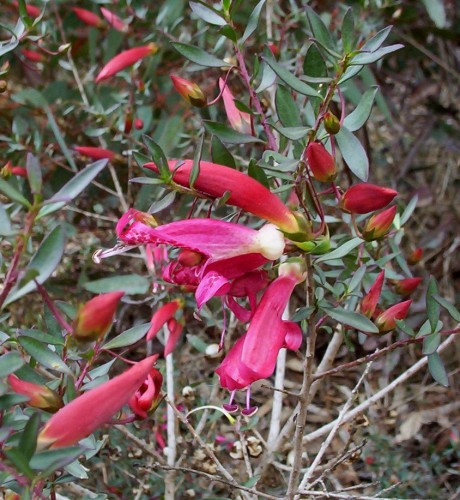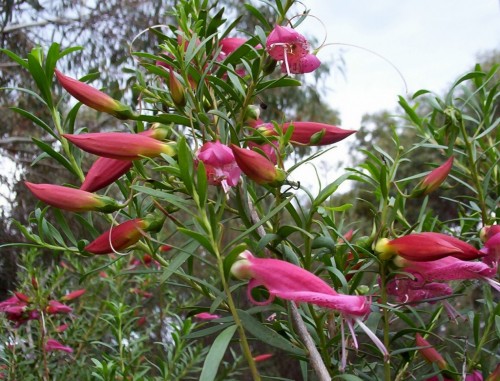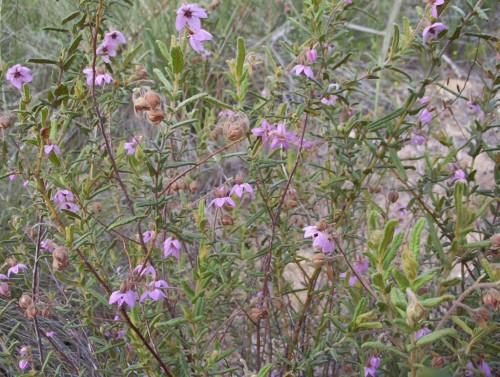Planting Eremophilas
This afternoon I spent some time clearing out gazanias from around the dripper lines and digging holes to replace plants that did not survive a dry period we had a few years ago. I decided that I would put in more eremophilas (emu bushes). The area is very dry but is also the entrance to our place and needs cheering up. Some groundcover Eremophilas will be needed so that they can grow down a small embankment. This is one that I thought would be good as it has proved itself to be very hardy and is flowering prolifically at the moment much to the delight of the New Holland Honeyeaters.
There is a list of hardy eremophilas here.
Eremophilas To Rescue
Eremophila purpurascens is one of the plants we need to rescue from the bulldozer. It is on the edge of the planting but will probably be damaged. We won’t be able to move it so as much cutting material as possible has been taken. After such a dry winter this is sparse so we put the hose on it trickling for half an hour to increase the material in this next week or so.
This is a pretty plant one and a half metres high and wide, flowering from August to October. Here it has some flowers at other times of the year too. It is a Western Australian species from an area of granite but it copes well with the high pH of the soil here. It is actually growing in fairly deep mallee sand which provides good drainage. It is also frost and drought hardy.
Eremophila maculata compact form (Emu Bush)
This compact form of Eremophila maculata is a delight. It only grows about 60cm tall by about the same wide. The flowers are out of proportion to the size of the plant, being the same size as those on Eremophila maculata (Spotted Emu Bush).
All the desirable qualities apply to this plant. It is small, frost and drought hardy and lime tolerant. I think this plant flowers for a much longer period than the standard Eremophila maculata. Everyone admires the brilliantly coloured flowers. Like all Eremophilas, it benefits from light pruning or trimming from a young age.
The Mallee Ringnecks adore it and they can’t be wrong. It was an amusing sight, which we caught with the camera, to see one of the locals fly to the vicinity of the bush, waddle up to it and proceed to pick the flowers, get the nectar from the base of the tube and drop the flower to the ground before proceding to the next flower. The ground surrounding the bush was littered with chewed flowers. Destructive little beast! Incredibly this bush produces so many flowers that the chewed ones were not missed.
Eremophila maculata (Spotted Emu Bush)
This is another very hardy plant. Eremophila maculata (Spotted Emu Bush) occurs in a number of colours and habits, from a shrub to two and half metres by about the same wide, to a sprawling plant about half a metre tall by about 2 metres across.
The plant in the photo is a dark pink form to 2 metres high and across here. It has large tubular flowers with spots inside the throat of the tube. The Honeyeaters absolutely love this shrub. They have been very busy nesting and arguing over territory and there seems to be a lot of different species around this year. The eremophilas are providing a wonderful food source at the moment.
This eremophila is one that grows best in heavier soil that is well drained. It is a very hardy plant. They don’t mind dappled shade for part of the day or the root competition from the nearby mallee trees. Soil with a very high pH like we have here is no bother either.
Eremophila maculata makes a great screening or hedge plant. It responds to very hard pruning by sending out many sprouts from the cut site.
Thomasia petalocalyx (Paper Flower)
One of my ambitions has been to get a photographic record of the Australian native plants which occur in the South Australian Mallee. In particular I want a record of flowering plants in the local mallee. We went for a drive the other day and found a few I haven’t seen flower for years. This could be due to the fact that we haven’t been in the area at this time of the year for ages.
Thomasia petalocalyx (Paper Flower) is one of the pretty local natives that grows well in the garden. This photo was taken in mallee scrub south of here. The plant grows to about a metre tall and is wider. The nodding flowers are a pretty mauve and have a papery quality about them. The bush seems to have flowers on it most of the year.
Once again this is a hardy, drought tolerant plant. The leaves are a little hairy which possibly means that it needs to be in an open position in areas where high humidity occurs. This plant also occurs in Western Australia and Victoria.




